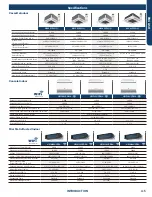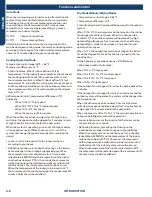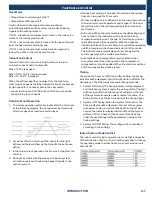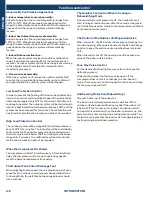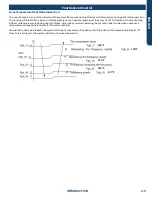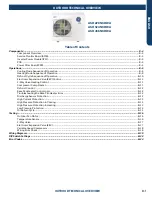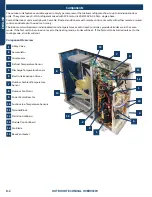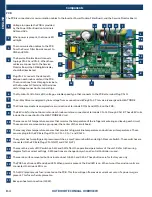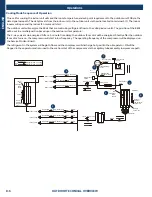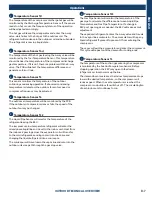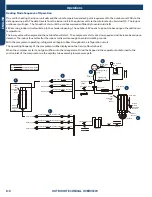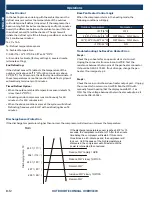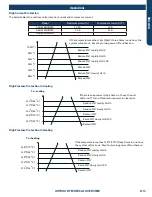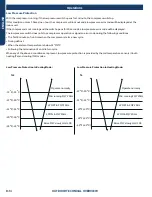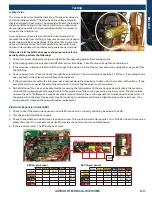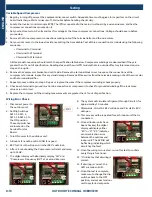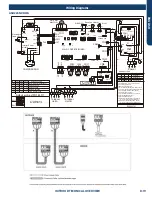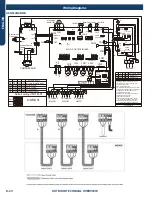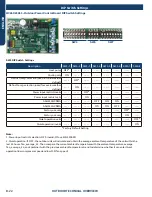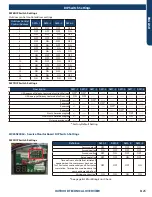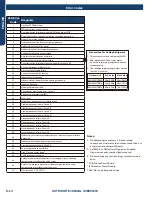
OUTDOOR TECHNICAL OVERVIEW
ENGLISH
B-9
Operations
1
Temperature Sensor Td
The temperature of the compressor discharge hot gas will be
monitored by the Discharge Temperature Sensor. If the sensor
reads too hot or cool, the frequency/status of the operation
will be adjusted as needed.
The hot gas will leave the oil separator and enter the 4-way
valve. The 4-way valve will direct the hot gas to ALL of the
indoor coils.
Note: Any indoor unit that is in heating mode will have it’s
louver open and indoor fan running. Non-calling indoor units
will receive hot gas but their fans will remain on very low speed
with the louver open. When demand for heat increases, the
indoor fan will speed up to meet the increased demand.
2
Temp. Sensor Tc1 & Indoor Heat Exchanger Temp. Sensor
The temperature of Tc1 should now be hot. This will indicate
the 4-way valve is directing hot gas to the indoor coils. If it
is not, there is a problem with the 4-way valve. The PCB will
detect the temperature difference and generate an Error
Code.
The indoor heat exchanger temperature sensor will monitor
the temperature of the indoor coil to ensure it is hot enough to
prevent blowing cold air. Once adequately warm temperature
is sensed at the indoor coil, the PCB will increase the fan speed
if needed to meet the demand.
The hot gas entering the indoor coil will condense into a
saturated mix and then be subcooled. The refrigerant will
return to the outdoor unit via the liquid line.
3
Temperature Sensor Tc2
This sensor monitors the temperature of the refrigerant liquid
returning from the indoor coil. The indoor EEV opening angle
is fixed.
The liquid will enter the Liquid Line Strainer and will pass
through the OPEN EEV.
The refrigerant liquid now enters a receiver where excess
refrigerant will store.
After the liquid leaves the Liquid Receiver, it will enter the
restriction of the OUTDOOR UNIT’s EEV, which changes the
liquid refrigerant to a lower pressure and temperature as it
enters the outdoor coil.
As the outdoor coil absorbs heat from the surrounding air, the
very cold liquid refrigerant is changed to a cool vapor. This
vapor travels through the 4-way valve to the accumulator.
4
Temperature Sensor Te
The outdoor coil temperature will be sensed by the Defrost
Sensor. The sensor will use this temperature to to adjust EEV
open angle and to calculate when a defrost cycle is necessary.
5
Temperature Sensor Toci
This temperature sensor is now sensing the suction line
temperature of the refrigerant vapor leaving the outdoor coil.
This temperature is used to adjust the EEV open angle.
The vapor refrigerant will then enter the 4-way valve and
be directed to the compressor suction accumulator. The
accumulator will prevent any remaining liquid refrigerant from
entering the compressor.
The vapor will exit the accumulator and enter the compressor.
This cycle repeats until the demand for heating ends.
6
Temperature Sensor Ts
The temperature of the suction gas entering the compressor
is monitored by the Suction Temperature Sensor.
As the demand becomes less while the indoor temperature
rises toward the desired temperature, the compressor will
reduce speed. When the set temperature is reached, the
compressor and outdoor fan will shut off. The circulating fan
of each indoor unit continues to run.
Содержание AB09SC2VHA
Страница 2: ...Oct 2020 Manual release Revision History ...
Страница 12: ... This page intentionally left blank ...
Страница 45: ...WALL MOUNT TECHNICAL OVERVIEW ENGLISH Topic Title C 9 Wiring Diagrams ...
Страница 68: ... This page intentionally left blank ...
Страница 78: ... This page intentionally left blank ...
Страница 104: ... This page intentionally left blank ...

